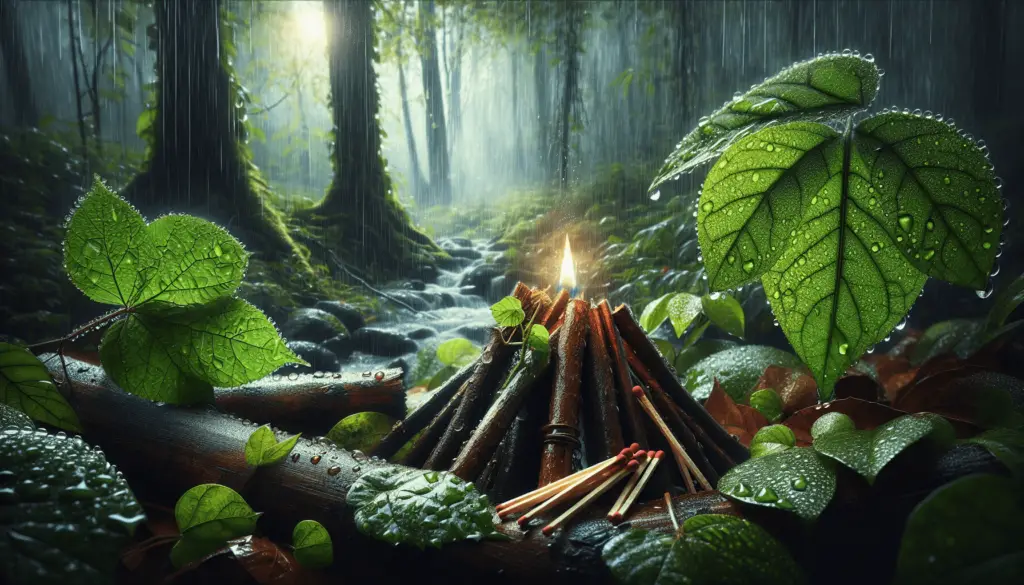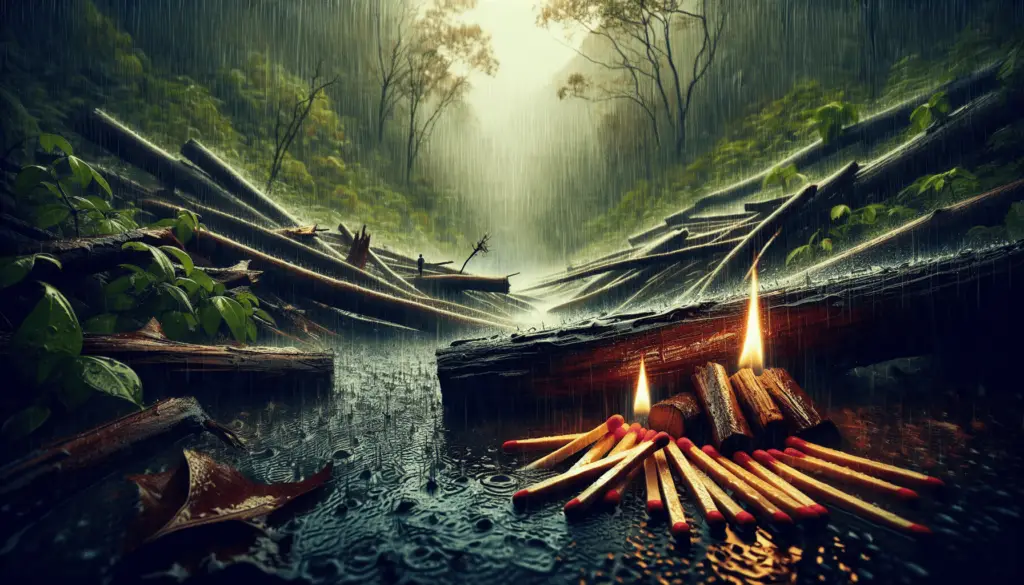Imagine you’re in the great outdoors, surrounded by lush greenery and the calming sound of raindrops falling. The only thing missing? A warm and crackling fire to keep you cozy. But wait, the ground is wet, and the wood is damp. Don’t worry, because in this article, we will share some practical tips on how to build a fire in wet conditions. From gathering dry tinder to using unconventional fire-starting methods, we’ve got you covered. So grab your raincoat and get ready to master the art of building a fire even in the wettest of conditions!
Preparing the site
Choose a sheltered location
When building a fire in wet conditions, it is crucial to choose a sheltered location. Look for a spot that is protected from wind and precipitation, such as under the cover of trees or against a rocky outcrop. This will help to prevent rain or snow from extinguishing your fire.
Clear away any debris
Before you start gathering materials, take the time to clear away any debris from your chosen site. Remove any wet leaves, sticks, or other objects that may hinder your ability to start a fire. Clearing the area will also help to reduce the risk of the fire spreading unintentionally.
Create a solid base
To avoid a wet and muddy fire bed, it is important to create a solid base. Look for a flat and elevated surface where you can build your fire. If the ground is wet, you can use rocks or logs as a base. This will help to provide a dry and stable foundation for your fire.
Gathering dry materials
Look for dry tinder
Tinder is essential to starting a fire, especially in wet conditions. Look for dry tinder such as dry grass, leaves, pine needles, or bark. These materials catch fire easily and will help ignite the larger pieces of wood. Ensure that your tinder is completely dry to increase your chances of successfully starting a fire.
Collect small twigs and branches
After finding dry tinder, collect small twigs and branches. These are the next step in building your fire. Look for sticks that snap easily and are not waterlogged. They should be small enough to fit into your hand, but not too thin that they burn out quickly. The smaller twigs will catch fire easily and create a solid base for your fire.
Find larger pieces of dry wood
In addition to tinder and small twigs, it is important to find larger pieces of dry wood. Look for branches or logs that are not soaked with moisture. These larger pieces of wood will provide fuel for your fire and ensure that it continues to burn. Gathering a variety of sizes will give you options as you progress in building your fire.

Creating a fire bed
Use rocks or logs as a base
Once you have selected your site and gathered your materials, it is time to start building your fire bed. Begin by using rocks or logs as a base. Place them in a circular or rectangular shape to create a boundary for your fire. This will help to elevate your fire off the wet ground and provide stability.
Construct a raised platform
On top of the rocks or logs, construct a raised platform using smaller twigs and branches. Crisscross them to create a mesh-like structure that will hold your fire. This platform will ensure that your fire has proper airflow, which is essential for it to burn efficiently.
Set up a bed of dry tinder
Once the raised platform is built, set up a bed of dry tinder on top. Arrange the tinder in a loose and airy manner, allowing for oxygen to reach it easily. This will enable the fire to ignite quickly once it is sparked. Ensure that the tinder is dry and ready for ignition.
Using fire-starting aids
Bring fire-starting aids
In wet conditions, it is advisable to bring fire-starting aids to assist in starting your fire. These aids can include commercially-made fire starters, dryer lint, or even homemade fire starter kits. These aids can help to ignite your tinder more quickly and efficiently, increasing your chances of successfully starting a fire.
Pack waterproof matches or a lighter
To effectively start a fire, it is essential to have reliable ignition sources. In wet conditions, pack waterproof matches or a lighter to ensure that you can ignite your fire even in damp environments. These tools will provide a consistent flame, making it easier to light your dry tinder.
Consider using a fire starter
If you anticipate particularly challenging conditions, consider using a fire starter. Fire starters are specifically designed to ignite and burn even in wet or windy conditions. They often come in the form of small blocks or pellets that burn for an extended period, providing a reliable and long-lasting flame to get your fire going.

Building a teepee-shaped fire
Arrange small twigs and branches
To build a teepee-shaped fire, begin by arranging small twigs and branches in a cone-like shape. Place the thinnest and driest pieces at the top, gradually increasing the size as you move downward. Leave an opening at the bottom to allow for airflow, which is crucial for a successful fire.
Add larger pieces of dry wood
Once the teepee structure is constructed, start adding larger pieces of dry wood to the fire. These larger pieces will provide fuel and help sustain the fire over a longer period. Gradually increase the size of the wood as the fire grows, ensuring a steady supply of fuel to keep the fire burning.
Ignite the tinder
With the teepee structure in place and the larger wood positioned, it is time to ignite the tinder. Use your chosen fire-starting aid, such as a lighter or matches, to carefully light the dry tinder at the base of the teepee. The flames will gradually climb up the twigs and branches, igniting the larger pieces of wood and creating a strong and consistent fire.
Building a log cabin fire
Create a base of kindling
To build a log cabin fire, start by creating a base of kindling. Set up two parallel logs on the ground, leaving a small gap between them. On top of these logs, lay a crisscross pattern of smaller sticks and branches. This base will provide a solid foundation for your fire and ensure proper airflow.
Arrange larger sticks around the base
Once the base is in place, start arranging larger sticks around it, leaning them against each other in a log cabin fashion. The gaps between the larger sticks will allow for airflow, promoting efficient burning. Make sure to leave an opening or chimney-like structure at the top to prevent the fire from becoming smothered.
Add more layers of alternating kindling
As your log cabin structure grows, continue adding more layers of alternating kindling. This means adding more parallel logs and crisscrossing smaller sticks and branches. Building up the layers will provide a sturdy structure that allows for proper airflow and creates a sustainable fire. The alternating layers of logs and kindling will ensure that the fire has a steady supply of fuel to continue burning.
Building an upside-down fire
Lay large logs as the base
To build an upside-down fire, start by laying large logs as the base. These logs should be thick and long, creating a solid foundation for the fire. Lay them parallel to each other, leaving a small gap between each log to provide airflow.
Stack smaller logs on top in a crisscross pattern
On top of the large logs, stack smaller logs in a crisscross pattern. This pattern will help promote even burning and provide airflow to sustain the fire. The smaller logs should be about the same length as the base logs, creating a sturdy and well-structured fire bed.
Place dry tinder on top of the logs
To finish building the upside-down fire, place a bed of dry tinder on top of the stacked logs. Make sure the tinder is loose, allowing for easy ignition. The small gaps between the logs will allow the fire to travel downward, igniting the smaller logs and eventually reaching the base logs. This method of building a fire creates a slow and long-lasting burn.
Protecting the fire from rain
Build a shelter above the fire
In wet conditions, it is important to protect your fire from rain or snow. Build a shelter above the fire using natural materials such as branches, leaves, or a tarp, if available. The shelter should cover the entire fire bed, leaving enough space for air circulation. This will help prevent precipitation from extinguishing the flames.
Cover the fire with a tarp or poncho
If you have a tarp or poncho available, you can use it to directly cover the fire bed. Ensure that the material is positioned securely and tightly, leaving no gaps for rain to enter. The cover should not come into direct contact with the flames to prevent it from catching fire. This method offers excellent protection against rain or snow.
Use natural materials to create a canopy
If you don’t have a tarp or poncho, you can create a canopy using natural materials. Look for large leaves or branches that can be used to cover the fire bed. This natural canopy will shield the fire from rain or snow, allowing it to continue burning. Ensure that the canopy is securely positioned and provides adequate coverage.
Maintaining the fire
Add small pieces of wood gradually
To keep your fire going, it is important to add small pieces of wood gradually. Adding too much wood at once can smother the fire or cause it to burn inefficiently. Monitor the fire and continuously feed it with small pieces of dry wood to maintain a consistent and sustained flame.
Keep the fire well-ventilated
Maintaining proper ventilation is essential for a successful fire. Ensure that there is enough airflow to keep the flames alive. Avoid overcrowding the fire with too much wood or covering it with objects that restrict airflow. By keeping the fire well-ventilated, you increase the chances of it burning steadily and providing warmth.
Avoid overcrowding the fire
While it is important to add fuel to keep the fire going, it is equally important to avoid overcrowding the fire. Overloading the fire with too much wood can lead to smothering and a lack of oxygen. This can cause the fire to die down or burn inefficiently. Maintain a balance by adding fuel gradually and ensuring that there is enough space for airflow.
Extinguishing the fire safely
Allow the fire to burn completely
Before extinguishing the fire, allow it to burn completely. Let the flames die down naturally and continue to burn until only glowing embers remain. This ensures that the fire has consumed all the fuel and reduces the risk of reignition once it is extinguished.
Disperse the ashes and coals
Once the fire has burned completely, it is important to disperse the ashes and coals. Use a stick or shovel to spread the ashes over a wide area, ensuring that there are no remaining hot spots. This step helps to prevent accidental fires and ensures that the fire is fully extinguished.
Pour water on the fire bed
To guarantee that the fire is safely extinguished, pour water over the fire bed. Use a bucket or container to carefully pour water to douse any remaining embers or heat. Continue pouring until you are confident that there are no remaining hot spots. This final step ensures that the fire is fully extinguished and reduces the risk of it reigniting.
Building a fire in wet conditions requires careful preparation, the right materials, and proper techniques. By following these steps, you can successfully build and maintain a fire even in challenging weather. Always prioritize safety and ensure proper extinguishing practices to minimize the impact on the environment and reduce the risk of wildfires. Stay warm and enjoy the benefits of a well-built fire in any condition!
